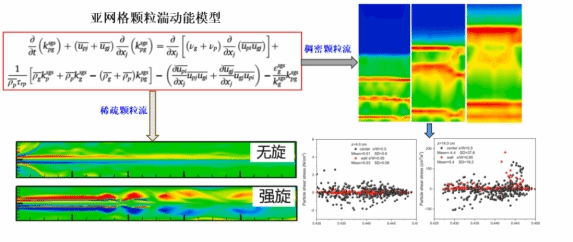Liu Yang’s team from the School of Intelligent Manufacturing has recently published their latest research findings in the internationally renowned journal Chemical Engineering Journal (a SCI Q1 journal with an impact factor of 13.2). The paper is titled “Investigation on Particle Slug Flow Using Large Eddy Simulation Combined with a Particle Kinetic Energy Model” with TU as the primary institution associated with the paper and Dr. Liu Yang as the first author and corresponding author. The research built upon their previous work “Hydrodynamic Modeling of Coaxial Confined Particle-Laden Turbulent Flow” published in the esteemed journal Energy (also a Q1 journal with an impact factor of 9.0).
Gas-solid multiphase turbulent flows are widely used in clean energy, chemical reactors, pharmaceuticals, and combustion industries. The extreme complexity of the spatial and temporal evolution, as well as the statistical laws of turbulent flow results in the limited knowledge of the nature of turbulent flow and heat transfer in multiphase reactions. Although some progress has been made in experimental studies, mechanistic models, and numerical simulation techniques, model optimization and a priori data validation still require thorough investigation.
This series of research work proposes, for the first time, a subgrid-scale particle turbulent kinetic energy model that considers the effect of gas-phase turbulence on particle motion. Based on the second-order moment multiphase turbulence model, we construct an anisotropic gas-solid interphase Reynolds stress transport model and an isotropic proposed particle temperature model. This enables a four-way coupling strategy to reveal the interaction mechanisms between the phases of multiphase flow.
Previous work involved investigating sparse gas-suspended particles in non-rotating and strong spinning turbulent flows, revealing the spatial and temporal evolution of the simulated ordered structure and the particle vorticity, as well as the statistical characteristics of particle motion.
Current work has encompassed the dense gas-particle turbulent throttling flow in a bubbling fluidized bed. The findings indicated that particle turbulent flow is strongly constrained by the kinematic behavior of bubbles, and the temperature of the simulated bubble particles is significantly higher than that of small-scale particles. The distribution of bubble Reynolds stress showed strong anisotropic properties.
These results lay an important theoretical foundation for further exploration and understanding of the mechanisms underlying multi-scale gas-solid multiphase turbulent flow.

This research was supported by the National Natural Science Foundation of China (Project No. 52078097) and the Natural Science Foundation of Zhejiang Province (Project No. LTGY24E060001) .
Link to the papers:
https://doi.org/10.1016/j.cej.2024.153112
https://doi.org/10.1016/j.energy.2023.128144